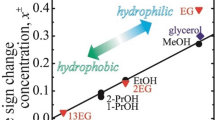Abstract
An analysis of different thermodynamic properties as a function of temperature provides valuable information about their characteristics. The ultrasonic velocity of the ternary mixtures ethanol+water+1-pentanol at the range 288.15–323.15 K and atmospheric pressure, has been measured over the whole concentration range. The experimental ultrasonic velocities have been analysed in terms of different theoretical models, an adequate agreement between the experimental and predicted values both in magnitude and sign being obtained, despite the high non-ideal trend and partial miscibility of the ternary mixture studied in this work. The obtained experimental values indicate varying extent of interstitial accommodation among unlike molecules as a function of steric hindrance attending to 1-pentanol as key component and as a function of hydrogen bond and temperature attending to ethanol as key component.
Similar content being viewed by others
References
Bevington. P., Data reduction and error analysis for the physical sciences, McGraw-Hill, New York (1969).
Cibulka, I., “A relation between excess volume and the form of the dependence of density on composition for binary-liquid mixtures,” Coll. Czech. Chem. Comm., 55(7), 1653 (1990).
Danusso, F., “Ultrasonic velocity and adiabatic compressibility of liquid mixtures,” Atti Accad. Nazl. Lince.i, 10, 235 (1951).
Eyring, H. and Kincaid, J. F., “The activate complex in chemical reactions,” J. Chem. Phys., (USA), 6, 620 (1938).
Gaiser, M., Bell, G.M., Lim, A.W., Roberts, N. A., Faraday, D. B. F., Schultz, R. A. and Grob, R., “Computer simulation of a continuous whisky still,” J. Food Eng., 51, 27 (2002).
Gayol, A., Iglesias, M., Concha, C.G., Goenaga, J.M., Gonzalez, C. and Resa, J.M., “Effect of temperature on thermophysicalmagnitudes of (ethanol+aliphatic elcohols (c4–c5)) mixtures,” J. M. Phys. Chem. Liq. (2005) (submitted for publication).
Gonzalez, C., Iglesias, M., Lanz, J. and Resa, J.M., “Temperature dependence of excess molar volumes in (n-alkane (C-6–C-9) or alcohol (C-2–C-4)) plus olive oil mixtures,” Thermochimica Acta., 328, 277 (1999).
Jacobson, B., “Intermolecular free lengths in the liquid state. 1. Adiabatic and isothermal compressibilities,” Acta Chemica Scandinavica, 6, 1485 (1952).
Marquardt, D.W., “An algorithm for least-squares estimation of nonlinear parameters,” J. Soc. Indust. Appl., Math 2, 431 (1963).
Nomoto, O., “Empirical formula for sound velocity in liquid mixtures,” J. Phys. Soc. Japan, 13, 1528 (1968).
Nutsch-kuhnkies, R., “Sound characteristics in binary mixtures and solutions,” Acustica, 15, 383 (1965).
Orge, B., Iglesias, M., Marino, G., Dominguez, M., Piñiro, M. and Tojo, J., “Mixing properties of benzene+2-methyl-2-butanol+1-pentanol at 298.15 K. Experimental results and comparison between ERAS model and cubic EOS estimations for excess molar volumes,” J. Fluid Phase Eq., 170, 151 (2000).
Orge, B., Iglesias, M., Rodriguez, A., Canosa, J.M. and Tojo, J., “Mixing properties of (methanol, ethanol, or 1-propanol) with (n-pentane, n-hexane, n-heptane and n-octane) at 298.15K,” Fluid Phase Eq., 133, 213 (1997).
Redlich, O. and Kister, A. T., “Algebraic representation of thermodynamic properties and the classification of solutions,” Ind. Eng. Chem., 40, 345 (1948).
Resa, J. M., Gonzalez, C., Goenaga, J.M. and Iglesias, M., “Temperature dependence of excess molar volumes of ethanol plus water plus ethyl acetate,” J. Solution Chem., 33(2), 169 (2004).
Schaaffs, W., Molekularakustic; eine einfuehurng in die zusammenhaenge zwischen ultrachall and molecuelstruktur in fluessigkeiten und gasen, Springer Verlag, Bonn (1963).
Schaffs, W., “Problem of a theoretical calculation of velocity of sound for binary-liquid mixtures,” Acustica, 33(4), 272 (1975).
Tejraj, M. A., Mirtyunjaya, I. A., Aralaguppi, B.G. and Rajashekhar, S. K., “Densities, shear viscosities, refractive-indexes, and speeds of sound of bis(2-methoxyethyl) ether with hexane, heptane, octane, and 2,2,4-trimethylpentane in the temperature interval 298.15-k-318.15-k,” J. Chem. Eng. Data, 39, 522 (1994).
TRC Thermodynamic Tables (Thermodynamic Research Center, Texas A&M University: College Station, TX, 1994).
Author information
Authors and Affiliations
Corresponding author
Rights and permissions
About this article
Cite this article
Resa, J.M., Goenaga, J.M., Concha, R.G. et al. Hydroxylic molecular interaction by measurement of ultrasonic velocity as a function of temperature: Ethanol+water+1-pentanol. Korean J. Chem. Eng. 23, 977–990 (2006). https://doi.org/10.1007/s11814-006-0018-y
Received:
Accepted:
Issue Date:
DOI: https://doi.org/10.1007/s11814-006-0018-y




